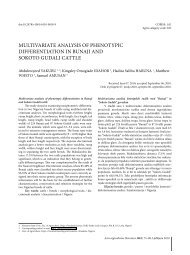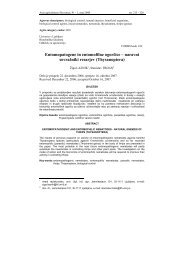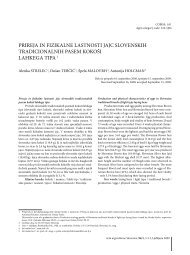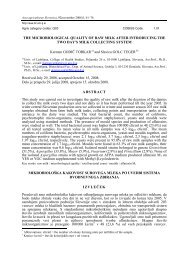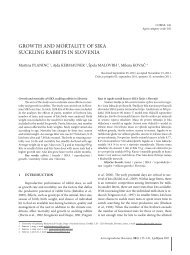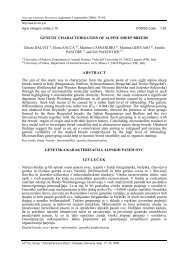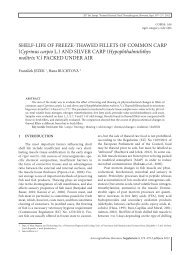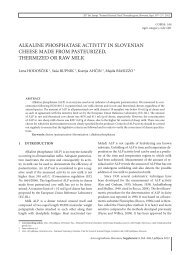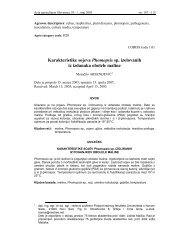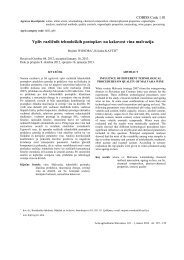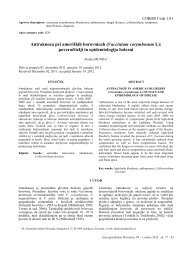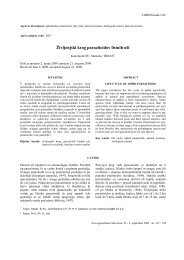IntrOduCtIOn PILOt BIOgAS reACtOrS And APPLICAtIOn tO defIne ...
IntrOduCtIOn PILOt BIOgAS reACtOrS And APPLICAtIOn tO defIne ...
IntrOduCtIOn PILOt BIOgAS reACtOrS And APPLICAtIOn tO defIne ...
Create successful ePaper yourself
Turn your PDF publications into a flip-book with our unique Google optimized e-Paper software.
<strong>IntrOduCtIOn</strong> <strong>PILOt</strong> <strong>BIOgAS</strong> <strong>reAC<strong>tO</strong>rS</strong> <strong>And</strong><br />
<strong>APPLICAtIOn</strong> <strong>tO</strong> <strong>defIne</strong> <strong>BIOgAS</strong> POtentIAL<br />
Of BASIC SuBStrAt, SwIne SLurry<br />
rajko BernIK 1 , Aleš ZVer 2<br />
Introduction pilot biogas reactors and application to define<br />
biogas potential of basic substrat, swine slurry<br />
Cooperation between the ‘Panvita group’ and the Biotechnical<br />
faculty, university of Ljubljana, resulted in the construction<br />
of a pilot biogas reactor – a miniaturised version of<br />
the economical biogas reactor. The aim of construction was<br />
to support scientific research in the field of biogas generation,<br />
while, at the same time, optimising the processes conducted in<br />
economical reactors and testing the new substrates in the field<br />
of biogas generation. A 2500-litre reactor, containing a 500-litre<br />
gasholder, was built to this purpose. In the first operating<br />
period, biogas-generation potential of the raw and partially purified<br />
swine slurries was tested. The three repetitions allowed<br />
us to generate an average of 529 litres CH 4 per 1 kilogram of<br />
organic dry matter.<br />
Key words: biogas reactor / pig slurry / biogas / methane /<br />
electric energy<br />
1 INTRODUCTION<br />
The reduction of CO 2 values in the atmosphere is<br />
a world goal (unfCCC, 1997). The eu member states<br />
have clear instructions to substitute the current fossil energy<br />
with renewable sources up to the value of 12% of<br />
the used gross energy by 2010. This means three times<br />
increasing the energy production from existent renewable<br />
sources in the eu.<br />
In Slovenia there are already some existent biogas<br />
stations and some are being built. Biogas plants immensely<br />
help reducing greenhouse gas emissions and<br />
COBISS: 1.01<br />
Agris category code: P05<br />
delo je prispelo 04. maja 2009, sprejeto 27. novembra 2009.<br />
received May 04, 2009; accepted november 27, 2009.<br />
Predstavitev pilotnega reaktorja in aplikativna določitev bioplinskega<br />
potenciala osnovnega substrata, prašičje gnojevke<br />
Biotehniška fakulteta in Skupina Panvita smo v sodelovanju<br />
postavili preizkusni bioplinski reaktor, ki je pomanjšana<br />
različica gospodarskega bioplinskega reaktorja. namen gradnje<br />
preizkusnega reaktorja je bil znanstveno raziskovalnem delo na<br />
področju pridobivanja bioplina in hkrati optimiziranje procesov<br />
v gospodarskih reaktorjih ter preizkušanja novih substratov<br />
v proizvodnji bioplina. Zgradili smo 2500 litrski reaktor,<br />
od celotnega volumna reaktorja je 500 litrov plinohrama. Kot<br />
cilj v prvem obratovalnem obdobju smo ovrednotili bioplinski<br />
potencial surove prašičje gnojevke in delno prečiščene prašičje<br />
gnojevke. Pravilno ovrednoten osnovni substrat je izhodišče<br />
za vse nadaljnje preizkuse, saj je to medij v katerem se bodo<br />
vrednotili vsi substrati ali mešanice substratov. S tremi ponovitvami<br />
smo dosegli v povprečju 524 litrov CH 4 na kilogram<br />
organske suhe snovi (OSS).<br />
Ključne besede: bioplinski reaktor / prašičja gnojevka /<br />
bioplin / metan / električna energija<br />
concurrently contribute a certain amount of renewable<br />
energy. The more biogas plants we have the bigger the<br />
effects of the test reactors will be, with which we can<br />
optimise the performance of biogas plants and test new<br />
substrates (Zver, 2005). Above all, the test reactors are intended<br />
for fast evaluation of a new organic mixture. This<br />
new organic mixture would be used in the actual reactor<br />
after the analysis of all the significant parameters for an<br />
economical and ecological performance of the reactor.<br />
The essential function of the test reactors is to enhance<br />
the economy of the real biogas plants.<br />
Biogas is the mixture of gasses, which originate<br />
1 univ. of Ljubljana, Biotechnical fac., dept. of Agonomy, Jamnikarjeva 101, SI-1000 Ljubljana, Slovenia, Prof., Ph.d., M.Sc., e-mail: rajko.bernik@bf.uni-lj.si<br />
2 Same address, Assist., e-mail: ales.zver@bf.uni-lj.si<br />
Acta argiculturae Slovenica, 94/2, 167–172, Ljubljana 2009
168<br />
r. BernIK and A. ZVer<br />
Table 1: Efficacy of biogas production from swine slurry<br />
Preglednica 1: Izpleni bioplina iz prašičje gnojevke po različnih avtorjih<br />
extent of biogas production Average biogas production<br />
Author<br />
(l/kg organic substance)<br />
(l/kg OdM)<br />
Swine slurry Beck, 1997 340–550 450<br />
Swine slurry gaćeša, 1985 550<br />
Swine slurry gobec, 2005 200–350 275<br />
Swine slurry Karpenstein-Machan, 2005 250–350 300<br />
l/kg – litres of biogas per kilogram of organic substance; OdM organic dry matter<br />
from anaerobic fermentation. Anaerobic fermentation is<br />
a biological process which is based on methanogenesis,<br />
where bacteria decompose organic material. The products<br />
of the process are mainly methane and carbon dioxide.<br />
The process can be simplified with the reaction: 2C +<br />
2H O à CH + CO (Đulbić, 1986).<br />
2 4 2<br />
There are many factors to ensure optimal biogas<br />
production. They fall into three categories:<br />
– – Physical : imported heat in the reactor, mixing of<br />
the organic mixture in the reactor, density, structure<br />
of the organic mixture in the reactor, specific<br />
yield (1/kg dM)<br />
– – Chemical : C:n ratio, pH, content of macro and<br />
micro elements, toxins, heavy metals<br />
– – Biological: type of microorganisms, their quality<br />
and quantity<br />
It is reasonable to search for and to optimise the<br />
mixture of different substrates in a test reactor. Thus we<br />
can ensure optimal exhaustion of substrates for biogas<br />
production and our findings can be applied in the economical<br />
devices.<br />
Kg rakičan eKOteH d.o.o. is a member of the<br />
Panvita group. They already operate a 1.3 Mw biogas<br />
plant and they are also currently building a new smaller<br />
biogas plant. The following substrates are imported in the<br />
existent biogas plant:<br />
13t of raw slurry, 8.5 t of by-products of animal origin<br />
(BPOAO2 and BPOAO3), 35.6t of maize silage, and<br />
60t of slurry.<br />
The article focuses on the biogas yield produced<br />
from swine slurry. Therefore, the results of preceding research<br />
will be presented as well. different authors quote<br />
various biogas yields. we could practically say that the<br />
span of results is too big and unrealistic. furthermore,<br />
the reason for the span is not given and this is the key<br />
factor for future assessment and planning of the device.<br />
Acta agriculturae Slovenica, 94/2 – 2009<br />
2 METHODs<br />
2.1 <strong>IntrOduCtIOn</strong> Of tHe teSt reAC<strong>tO</strong>r<br />
A pilot reactor was built in the immediate vicinity<br />
of the existent biogas plant (fig. 1). Its purpose is optimising<br />
the functioning of economical biogas plants and<br />
testing new substrates. The volume of the pilot reactor<br />
is 2500 litres, from which the working volume is 2000<br />
litres and the remaining 500 litres is intended for the gasholder.<br />
It is a miniature version of the economical biogas<br />
reactor. In it we can test substrates processed in the same<br />
manner as in the economical biogas reactor.<br />
2.2 COMPOnentS Of tHe reAC<strong>tO</strong>r<br />
– – The stirring device is placed horizontally and<br />
driven by a 500w electro engine.<br />
– – The heating appliance is placed inside on the<br />
walls of the reactor; it is heated by water from an<br />
outer heating source.<br />
– – The additional – auxiliary stirring device is adjustable<br />
in the spill-over edge, which prevents<br />
clogging of the exit; it is driven by a 350w engine.<br />
– – The swine slurry pump is driven by an electrical<br />
engine and is used to pump the purified slurry<br />
into the reactor. It pumps 2 litres of slurry per<br />
minute, taking into account the losses in the<br />
pipeline. we can set the intervals of the pumping<br />
of the slurry and the amount of it.<br />
– – The opening for adding additional substrates is a<br />
funnel-shaped opening into which, at certain intervals,<br />
substrates are added. due to stirring the<br />
opening is being gradually emptied and thus it<br />
ensures a continuous filling.<br />
– – The biogas flow-metre is a mechanical counter.<br />
It notes the biogas flow on the basis of the turns<br />
of the spades. In our case the spades are being<br />
driven by the biogas.<br />
– – The analyser of the biogas quality is portable. It
<strong>IntrOduCtIOn</strong> <strong>PILOt</strong> <strong>BIOgAS</strong> <strong>reAC<strong>tO</strong>rS</strong> <strong>And</strong> <strong>APPLICAtIOn</strong> <strong>tO</strong> <strong>defIne</strong> <strong>BIOgAS</strong> ... SuBStrAt, SwIne SLurry<br />
Figure 1: Test reactor (on the left: view from the front, on the right: view from the back).<br />
Slika 1: Preizkusni reaktor (levo: prednja stran, desno: zadnja stran).<br />
is used to analyse the biogas quality in certain intervals<br />
or when needed. we can measure % CH , 4<br />
% CO , % O , and ppm H S.<br />
2 2 2<br />
– – The control box with a computer controls all the<br />
devices in the reactor except for the analyser of<br />
the biogas quality. The software enables the setting<br />
of the intervals for the stirring devices and<br />
the pump. It also provides a simultaneous register<br />
of the data during the intervals.<br />
– – Other equipment includes the laboratory with all<br />
the necessary equipment and other equipment<br />
for storage and handling of substrates.<br />
– – Sampling pints. The reactor has six exits with<br />
ball-bearing valves, which enable sampling for<br />
the analysis. two of these are 80mm in diameter.<br />
– – The window is a glass door. we can observe the<br />
occurrence in the reactor from the top.<br />
2.3 wOrKIng wItH tHe reAC<strong>tO</strong>r<br />
The working volume of the reactor (2000 litres) is so<br />
big that the processes in it cannot be completely controlled<br />
and directed. Processes which are equal to those in<br />
the economical reactor are: complete stirring (usually a<br />
crust occurs on the substrates with a major proportion<br />
of dryness and fibres), emissions of biogas, comparable<br />
fluctuation of pH, structures of different microorganisms,<br />
etc.<br />
The test reactor gives us more tangible results for<br />
a certain substrate in comparison to the results given in<br />
certain literatures, which usually contain average results<br />
gained in smaller reactor laboratories under optimal<br />
conditions. The results are then used directly in the economical<br />
reactor. Thus the fluctuation of the economical<br />
reactor is optimised. Concurrently, we can analyse the<br />
functioning of the test device.<br />
2.4 InItIAtIOn Of tHe teSt reAC<strong>tO</strong>r<br />
The pilot reactor was filled with the mixture of bacteria<br />
from the anaerobic part of a purification device or<br />
an old biogas plant. The temperature was set to 37.5 °C<br />
with ±1.5 °C deviation. The stirring was adjusted to the<br />
economical devices. The swine slurry was gradually added.<br />
After having established that the test reactor func-<br />
Acta agriculturae Slovenica, 94/2 – 2009 169
170<br />
r. BernIK and A. ZVer<br />
Figure 2: Sketch of the test reactor (front view and ground plan).<br />
Slika 2: Skica preizkusnega reaktorja (naris in tloris).<br />
tions perfectly, we started with the systematic research of<br />
the test reactor.<br />
2.5 CHOOSIng tHe BASIC SuBStrAte<br />
during the first weeks of the operation we determined<br />
daily fluctuation of biogas production. we started<br />
researching the reasons for the unbalanced biogas production.<br />
The cause for this was the quality of the raw<br />
swine slurry and the changing dryness from 0.5% to 7%.<br />
The dryness of the swine slurry depended on the day of<br />
the week. during weekends the stables are not washed.<br />
during weekdays the stables are being washed, adding<br />
the water used for washing to the common reservoir of<br />
the slurry. from there the slurry is taken for the use in<br />
the experimental reactor. Another occurrence of unbal-<br />
Acta agriculturae Slovenica, 94/2 – 2009<br />
anced production was detected when the pipe for adding<br />
raw swine slurry was clogged by a ball of swine hair.<br />
The flow was lower than we expected. However, these<br />
are technical problems which can be solved by designing<br />
the device correctly. According to the above described<br />
technical problems we decided to use partially purified<br />
swine slurry with dryness between 1% and 1.5%. Thus<br />
we ensured that the input material is homogeneous and<br />
avoided technical stirring problems. The swine slurry<br />
under consideration has a very specific composition. On<br />
average it contains 41% of ash in dry matter.<br />
2.6 eVALuAtIOn Of SwIne SLurry<br />
The purified swine slurry will in future be the basic<br />
medium in the reactor. Thus we needed to assess its en-
<strong>IntrOduCtIOn</strong> <strong>PILOt</strong> <strong>BIOgAS</strong> <strong>reAC<strong>tO</strong>rS</strong> <strong>And</strong> <strong>APPLICAtIOn</strong> <strong>tO</strong> <strong>defIne</strong> <strong>BIOgAS</strong> ... SuBStrAt, SwIne SLurry<br />
Table 2: Basic statistics of biogas produced from partially purified swine slurry<br />
Preglednica 2: Osnovna statistika bioplina iz surove in delno prečiščene prašičje gnojevke<br />
Biogas production in 10 days<br />
Substrate<br />
Min. Max. Average Median Standard deviation Produced biogas (l)<br />
Slurry 1 70 510 240 200 141 2405<br />
Slurry 2 280 420 379 398 53 3790<br />
Partially purified slurry 3 250 320 284 298 28 2840<br />
Partially purified slurry 4 225 320 267 265 33 2665<br />
ergy potential at a certain residence time. we decided on<br />
a 30-day residence time. The purified swine slurry had<br />
41% of ash in dry matter. After months of evaluation we<br />
gained the sought data for this swine slurry, biogas yield<br />
per kilogram of dry matter, and biogas yield per kilogram<br />
of organic dry matter. However, we did not seek for nondegradable<br />
organic dry matter.<br />
3 REsULTs aND DIsCUssION<br />
during the first three months of production, we<br />
were evaluating biogas potential of the raw swine slurry<br />
and partially purified swine slurry. figure 3 and table 2<br />
show biogas productions in time periods 1, 2, 3 and 4. In<br />
the time periods 1 and 2 we used raw swine slurry. However,<br />
due to its physical characteristics it was not suitable<br />
to include it in further experiments. The main problem<br />
was the unbalanced amount of dry matter. In the time<br />
periods 3 and 4 we evaluated partially purified swine<br />
slurry. This is shown in figure 3. Curve 1 shows that raw<br />
swine slurry is not suitable as the basic substrate because<br />
of dryness volatility. Curve 2 shows operation with raw<br />
slurry. However, in this case the slurry was left in a container<br />
for the thick part to sediment. we only used the<br />
cleaner upper part of the slurry, but the volatility of the<br />
dryness was still too high. Thus it is not suitable to be<br />
used as the basic substrate.<br />
table 2 shows data about the biogas yield from slurry<br />
tested during certain time periods. The standard deviation<br />
with raw slurry is immense. Thus it is not suitable<br />
to be used as the basic substrate in further experiments.<br />
3.1 <strong>BIOgAS</strong> POtentIAL Of PArtIALLy PurIfIed<br />
SwIne SLurry<br />
due to technical problems and homogeneity of the<br />
basic substrate we decided to use partially purified swine<br />
slurry. In table 3 we see the average biogas yield for a<br />
Figure 3: Biogas production per day during the evaluation of biogas potential of raw swine slurry (1 and 2) and partially purified<br />
swine slurry (3 and 4).<br />
Slika 3: Produkcija bioplina po dnevih pri vrednotenju bioplinskega potenciala surove gnojevke (1 in 2) in delno prečiščene prašičje<br />
gnojevke (3 in 4).<br />
Acta agriculturae Slovenica, 94/2 – 2009 171
172<br />
r. BernIK and A. ZVer<br />
Table 3: Chemical characteristics of partially purified swine<br />
slurry and biogas yield<br />
Preglednica 3: Kemične lastnosti delno prečiščene prašičje<br />
gnojevke in izplen bioplina<br />
% dM<br />
Substrate<br />
Partially purified swine slurry<br />
1.0–1.5<br />
% CA* in dM 44<br />
C : n 36<br />
Biogas / litre of slurry (l) 5.29<br />
Biogas / kg dM (l) 423<br />
Biogas / kg OdM (l) 756<br />
CH / litre of slurry (l) 4 3.71<br />
CH / kg dM (l) 4 296<br />
CH / kg OdM (l) 4 529<br />
*CA = crude ashes, Bg; we gained comparable results with previous<br />
researchers on the test biogas reactor.<br />
20-day period. we used a total of 1040 litres of slurry and<br />
produced 5505 litres of biogas or 3854 litres of methane.<br />
we reached the average biogas yield of 275 litres per day,<br />
or 756 litres of biogas per kilogram of organic dry matter,<br />
or 423 litres per dry matter. The average biogas composition<br />
is: CH 4 70%, CO 2 30%, O 2 0% in 1500 ppm H 2 S.<br />
4 CONCLUsION<br />
we evaluated the biogas potential of specific swine<br />
slurry. Partially purified swine slurry has specific characteristics<br />
in comparison with other slurries mentioned by<br />
other authors. It was reasonable to use partially purified<br />
slurry. It gave us valuable information concerning its biogas<br />
potential.<br />
In future, partially purified swine slurry will be used<br />
as the basic medium for testing and determining the biogas<br />
potential of different substrates. One of the examples<br />
is the mixture of partially purified slurry and silage.<br />
from the gross produced biogas, gained from this mixture,<br />
we mathematically subtract the produce of partially<br />
Acta agriculturae Slovenica, 94/2 – 2009<br />
purified swine slurry. Thus we gain the net biogas yield<br />
from certain substrate. Partially purified slurry will also<br />
hold the function of a means of transportation into the<br />
biogas reactor for different substrates. Thus, with the help<br />
of the fluid partially purified slurry, for which the energy<br />
potential is already known, we can import into the reactor<br />
organic material with bigger content of dry matter.<br />
This enables us to define the common or partial energy<br />
potential, or we can anticipate the energy utility of a certain<br />
organic material.<br />
5 REFERENCEs<br />
Beck J. 1997. Anaerobic treatment. In: Manure managment.<br />
treatment strategies for sustainable agriculture. Burton<br />
C.H. (ed.). Bia, Silsoe research Institute: 79–88<br />
Đulbić M. 1986. Biogas: dobijanje korišćenje i gradnja uređaja.<br />
Beograd, tehnička knjiga: 171 p.<br />
gobec I. 2005. (So)substrati pri proizvodnji bioplina. društvo<br />
za energetsko ekonomiko in ekologijo.<br />
http://www.ljudmila.org/sef/stara/bioplin05/predstavitve_<br />
in_fotografije/predstavitve/postojna/so)substrati%20<br />
pri%20proizvodnji%20bioplina%20postojna.pdf (7. nov.<br />
2007)<br />
gaćeša S., Vrbaški L., Baras J., Knežić L., Kašnja M., Zidanski f.<br />
1985. Biogas-proizvodnja i primena. novi Sad, tehnološki<br />
fakultet: 233 p.<br />
Karpenstein-Machan M. 2005. energiepflanzenbau für Biogasanlgenbetreiber.<br />
frankfurt am Main. dLg-Verlags-gmbH:<br />
191 p.<br />
Medved S., novak P. 2000. Biomasa. In: Varstvo okolja in obnovljivi<br />
viri energije. Ljubljana, fakulteta za strojništvo:<br />
231 p.<br />
Polprasert C. 1996. Organic waste recycling. technology and<br />
management. 2 nd edition. west Sussex, John wiley & Sons:<br />
412 p.<br />
rempel H. 2003. ressourcen und Verfügbarkeit von energierohstoffen<br />
2003. – XXVIII. 426 S., e. Schweizerbart’sche<br />
Verlagsbuchhandlung (nägele und Obermiller), ISBn<br />
3-510-95900-0, Stuttgart.<br />
unfCCC. 1997. The Kyoto Protocol to the united nations<br />
framework Convention on Climate Change. fCCC/CP<br />
1997/7Add.1,4.<br />
Zver A. 2005. Obnovljivi viri energije, rastlina kot energija in<br />
rastlina kot hrana. diplomsko delo. Ljubljana, univ. v Ljubljani,<br />
Biotehniška fakulteta, Odd. za zootehniko: 67 p.




